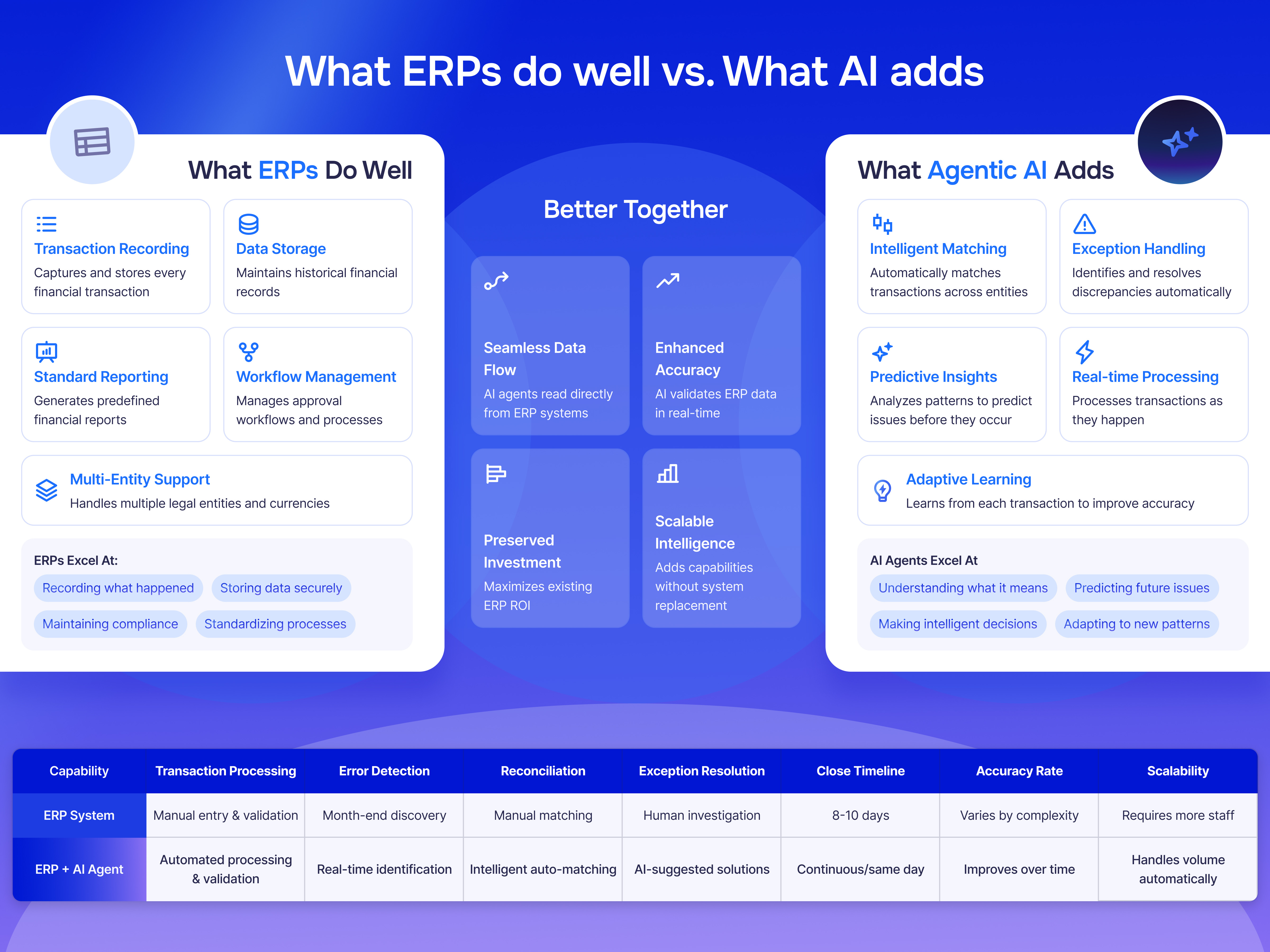
Automation in accounting for manufacturing helps finance teams eliminate manual reconciliations, streamline intercompany eliminations, and maintain accurate inventory accounting. It works alongside existing ERP systems to improve speed, accuracy, and audit readiness without requiring system replacement.
If you’re still closing the books in spreadsheets, your ERP isn’t cutting it.
Manufacturing finance teams operate in some of the most complex accounting environments, with multi-entity structures, distributed plants, high inventory velocity, and intercompany transactions that cross borders and currencies.
Yet many teams are still relying on ERP systems that weren’t built for this level of complexity. The result? Reconciliations take weeks, close processes stall, and reporting becomes a manual, error-prone grind.
This is where automation in accounting for manufacturing becomes not just helpful, but essential. By introducing intelligent automation alongside your existing ERP, you can eliminate the hidden cost of manual work without overhauling your systems.
The Cost of Manual Accounting in Manufacturing
Let’s start with the pain. Most ERP systems in manufacturing companies, from Sage X3 and Epicor to Microsoft BC and Oracle, were designed to record transactions, not automate accounting workflows. As finance teams grow and operations globalize, these systems fall short.
The consequences show up in the day-to-day. Below are a few of the most common challenges manufacturing finance teams face when trying to close the books, explain variances, and manage compliance using systems not designed for modern workflows.
- Manual reconciliations: Accountants spend days reconciling sub-ledgers (GL, AP, AR, inventory) and tracking down discrepancies.
- Intercompany complexity: Matching transactions and eliminating them across entities is time-consuming and often handled outside the ERP.
- Inventory blind spots: Real-time inventory valuation is nearly impossible without layering spreadsheets on top of ERP reports.
- Delayed close: With so many moving parts, close timelines stretch and teams burn out just trying to stay accurate.
Every extra day spent in Excel is a drag on strategic work, audit readiness, and decision-making. And as the business scales, the risks only grow.
Recommended read: How Generative AI in Finance Is Reshaping Accounting Workflows
Why Most Manufacturing ERPs Fall Short
The problem isn’t that ERPs don’t work, it’s that they weren’t built to handle the close. Manufacturing ERPs excel at capturing transactions on the shop floor or in procurement workflows, but when it comes to financial consolidation, intercompany eliminations, and variance analysis, they often leave teams on their own.
Instead of automating these workflows, most ERPs require custom scripts, bolt-ons, or external tools that complicate the stack and slow things down. Finance teams end up juggling multiple systems with little control over data integrity.
These gaps become more visible as organizations grow: more entities, more currencies, more regulations. Without automation, the accounting team becomes the bottleneck, not the enabler.
What Automation in Accounting for Manufacturing Actually Means
Automation isn’t just about speed, it’s about accuracy, control, and freeing finance from low-value manual tasks.
With a platform like Nominal, accounting teams can address specific pain points in the close and reporting cycle, each one ready for automation with tangible benefits.
Reconcile Sub-Ledgers Daily
Rather than waiting until period-end to uncover issues, Nominal automates sub-ledger reconciliations on a daily basis. This lets accounting teams identify mismatches between systems (like inventory and GL) early, reducing month-end surprises and eliminating last-minute fire drills.
Eliminate Intercompany Friction
Intercompany transactions are one of the most time-consuming areas in manufacturing accounting.
With Nominal, entries are automatically matched and cleared based on predefined logic and contextual data, drastically cutting time spent on eliminations and reducing the risk of missed adjustments.
Analyze Variances in Real Time
Instead of scrambling to explain fluctuations after the fact, Nominal’s AI agents continuously monitor and analyze variances. They detect unusual patterns, surface explanations, and even draft flux commentary, freeing up teams to focus on exceptions, not mechanics.
Maintain Audit-Ready Documentation
Every automated action taken in Nominal, from journal proposals to approvals, is logged and traceable. This ensures all workflows are backed by clean documentation, making audits faster and giving leadership confidence in financial integrity.
This is automation as a strategic enabler, not a temporary fix. It gives finance leaders real-time visibility across plants, product lines, and geographies.
What Finance Leaders Gain from Automation
For CFOs and Controllers in manufacturing, automation unlocks more than time savings:
- Faster close cycles: Move from 15-day closes to a continuous close environment where books are ready within days.
- Improved accuracy and controls: Eliminate human error and enforce consistent rules across all entities.
- Scalable infrastructure: Handle more volume, more complexity, and more entities without increasing headcount.
- Stronger audit posture: Centralize documentation, flag anomalies, and demonstrate controls to auditors with confidence.
- More strategic finance teams: Shift the team’s focus from data collection to analysis, from fixing issues to preventing them.
These gains don’t require replacing your ERP, just complementing it with tools designed for today’s finance needs.
Related post: 10 Real-World AI Agents Examples That Go Beyond ERP Limits
How Nominal Works With Your ERP Stack

Modern accounting automation platforms are designed to sit alongside your ERP, not replace it.
This approach is especially important in manufacturing, where ERPs like Sage X3, Epicor, Microsoft BC, SAP, and Oracle are deeply embedded across operations.
Rather than forcing a migration, automation tools connect directly to your ERP through APIs or data pipelines, pulling transactional data into an intelligent layer purpose-built for finance.
Once integrated, the automation layer applies a set of rules and workflows tailored for reconciliation, consolidation, intercompany eliminations, and variance analysis.
AI agents support finance teams by surfacing anomalies, proposing journal entries, and maintaining documentation, always with human oversight. The result is faster, more accurate financial operations without adding complexity to your ERP stack.
For manufacturers managing multi-entity operations, automation in accounting isn’t just about optimization, it’s a requirement for scale. ERPs aren’t going anywhere, but their limitations in core finance workflows are clear.
By layering automation on top of your existing systems, you gain the speed, accuracy, and visibility needed to close faster and lead with confidence.
Book a demo to see how Nominal works in your ERP environment and learn how your team can automate reconciliations, eliminate intercompany friction, and close faster with confidence






